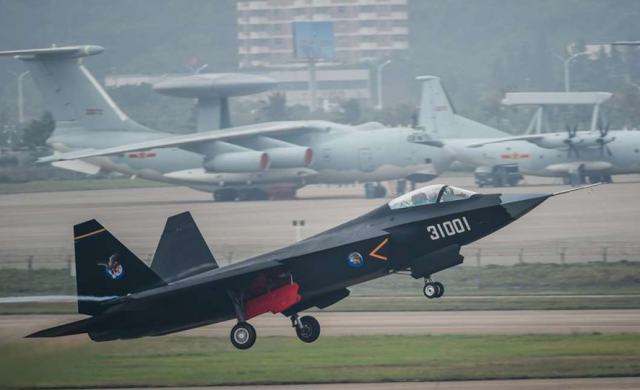China has tested the latest version of its fifth-generation J-31 stealth fighter The newest version of the J-31, now renamed the FC-31 Gyrfalcon, took to the air for the first time on Friday, the China Daily reported.
The new FC-31 has “better stealth capabilities, improved electronic equipment and a larger payload capacity” than the previous version which debuted in October 2012, the newspaper said, quoting aviation expert Wu Peixin.
“Changes were made to the airframe, wings and vertical tails which make it leaner, lighter and more manoeuvrable,” Wu told the paper.
The FC-31 Gyrfalcon can carry 8 tons of weapons The FC-31 has a maximum take-off weight of 28 metric tons, a flight radius of 1,250 km, and a top speed of Mach 1.8 or 1.8 times the speed of sound. The aircraft can easily carry 8 tons of weapons, holding six missiles in its internal weapons bay, plus six more under its wings.
Sergey Kornev, head of Russia’s Air Force Equipment Export Department, earlier told RIA Novosti the J-31 will fly on Russian aircraft engines RD-93.
The jet is manufactured by Shenyang Aircraft Corp, a subsidiary of the Aviation Industry Corp of China.
The fighter will be exported to other countries is expected to sell for about US$70 million, the article said, aiming to take market share away from more expensive fourth-generation fighters like the Eurofighter Typhoon.
In the 1960s, China worked from the blueprints and other materials, and eventually produced the J-7, a virtual copy of the Soviet MiG-21. The Chinese eventually sold the J-7 (F-7 export variant) in direct competition with the MiGs sold by the Soviets. Indeed, after the US-PRC rapprochement of the early 1970s, the Chinese sold J-7s directly to the Americans, who used them as part of an aggressor squadron to train US pilots to fight the Soviets.
In the 1990s there were several huge arms deals between Moscow and Beijing. One of the most important involved the sale, licensing, and technology transfer of the Su-27 “Flanker” multirole fighter. The deal gave the Chinese one of the world’s most dangerous air superiority fighters, and gave the Russian aviation industry a lifeline. China produced the J-11 as a copy of the Su-27.
Americans analysts suspected that China was stealing information associated with the F-35. The Snowden leaks confirmed extensive Chinese industrial espionage. The likely reality of this theft became clear when information about the J-31 stealth fighter became available. The J-31 looks very much like a twin-engine F-35, without the VSTOL capabilities of the F-35B.

Brian Wang is a Futurist Thought Leader and a popular Science blogger with 1 million readers per month. His blog Nextbigfuture.com is ranked #1 Science News Blog. It covers many disruptive technology and trends including Space, Robotics, Artificial Intelligence, Medicine, Anti-aging Biotechnology, and Nanotechnology.
Known for identifying cutting edge technologies, he is currently a Co-Founder of a startup and fundraiser for high potential early-stage companies. He is the Head of Research for Allocations for deep technology investments and an Angel Investor at Space Angels.
A frequent speaker at corporations, he has been a TEDx speaker, a Singularity University speaker and guest at numerous interviews for radio and podcasts. He is open to public speaking and advising engagements.


